 The Academy now feels empowered with the freedom to award animated films outside the traditional sphere of the Hollywood Studios. Last year, one of their own started making films outside the studio system – and it won. This year the Shorts branch put up another such film (from another American studio director gone “indie”), as well as two from Warner Bros. (a traditionally slapstick Sylvester cartoon and a Chuck Jones’ “artistic masterpiece”), a Disney two-reeler (which was trying out an innovative new technical process: the xerox machine), and an independent cartoon from Czechoslovakia.
The Academy now feels empowered with the freedom to award animated films outside the traditional sphere of the Hollywood Studios. Last year, one of their own started making films outside the studio system – and it won. This year the Shorts branch put up another such film (from another American studio director gone “indie”), as well as two from Warner Bros. (a traditionally slapstick Sylvester cartoon and a Chuck Jones’ “artistic masterpiece”), a Disney two-reeler (which was trying out an innovative new technical process: the xerox machine), and an independent cartoon from Czechoslovakia.
But what other cartoons were submitted to the Academy for Oscar consideration but failed to make the cut. We answer that question below. But first…
This week: 1960
The actual nominees were:
GOLIATH II (Disney) Wolfgang Reitherman [View]
HIGH NOTE (Warner Bros.) Chuck Jones [View]
MOUSE AND GARDEN (Warner Bros.) Friz Freleng [View]
A PLACE IN THE SUN (George K. Arthur/Go Pictures) Frantisek Vystrical (View)
And the Oscar went to:
MUNRO (Rembrandt/Paramount) Gene Deitch, director. [View]
The Oscar was awarded to Munro producer William L. Snyder by presenters Wendell Corey and Susan Strasberg. No video of the Best Shorts presentation has been located, but here are two backstage photos of Snyder (with Strasberg at right) holding Deitch’s award.

In retrospect, the Oscar going to Munro seems the obvious choice – The Academy was finally recognizing what Gene Deitch and his crew were doing. Jules Feffier was also quite “hot” among the new print cartoonists and satirists of the era, and the Munro film itself was a charmer. Capturing Feffier’s style perfectly to animation, with Howard Morris’ great vocal track, even the Czech animation crew couldn’t go too far “off model” – the model here was new and different. The film may be timeless – but this was its moment.
However – submitted, screened, but NOT nominated were:
 THE BLACK CAT (Continental) Robert Braverman
THE BLACK CAT (Continental) Robert Braverman
THE COW ON THE MOON (Zagreb) Dusan Vukotic
I WAS A TEEN-AGE MAGOO (UPA) Clyde Geronimi
THE INTERVIEW (Pintoff Productions) Ernest Pintoff
PICOLO (Zagreb) Dusan Vukotic
SNOOPY LOOPY (Columbia) William Hanna & Joseph Barbera
SOUTHERN FRIED HOSPITALITY (Lantz) Jack Hannah
SPRINGY BRIDGEWORK (aka SAMSON SCRAP) (Paramount/Rembrandt) Gene Deitch
TIN PAN ALLEY CAT (Terrytoons) Dave Tendlar
TOP CAT (Paramount) Seymour Kneitel
Here’s the documentation:


An incredible mix of material at this year’s screening: foreign films, independent animation, studio shorts (some of which cross the border into the realm of TV cartoons).
With these posts we ask that you put yourself in their place – which films would you have nominated? Which cartoon should have won? For your edification and viewing pleasure, here are the cartoons that didn’t make the cut. Enjoy the show!
THE BLACK CAT (Continental) Robert Braverman
Unavailable (thus far) to view, this two-reeler is based on Edgar Allen Poe’s classic tale – and narrated by Basil Rathbone. The story is told using more than fifty paintings by fine artist John Fenton, filmed and edited by Robert Braverman, with special effects and photography by animation veteran Larry Lippman.
Braverman was a film editor and freelance documentary filmmaker (educational and industrial films, Candid Camera, Lowell Thomas shorts, etc.). Lippman began as an office boy for Max Fleischer. He was eventually promoted and became a planner, checker, and then cameraman. He left Fleischer Studios during WWII to work in the Army Signal Corps as an animation cameraman. Eventually he opened his own company in New York City (L&L Animation), working with animation and optical effects – and later became head of the camera department for Jam Handy in Detroit.
I have not seen this film – and if anyone can find it for us I would be grateful.


THE COW ON THE MOON (Zagreb) Dusan Vukotic
I love this film. A pleasure to watch. A Zagreb cartoon that looks like a mash-up of UPA, Tex Avery and Ward Kimball. A brainy little girl tricks her bratty brother into thinking he’s taking a trip to the moon (she actually wheels her makeshift space craft into a rocky ravine). Thinking he’s on another planet, he encounters two aliens – one a cow, the other his sister in a space man get up. Beautifully animated in pantomime, timed to the music, with stretch and squash, funny drawings, offbeat character design and frequent breaking the fourth wall. Oh, how I wish this were nominated.
I WAS A TEEN-AGE MAGOO (UPA) Clyde Geronimi
Steve Bosustow attempted to continue UPA after the failure of 1001 Arabian Nights with a series of self-produced theatrical shorts – the first one we showed last week, Magoo Meets McBoing Boing. Here was the second short.
This is an odd one. The most UPA aspect of it is the background designs by Tom Yakutis, which are very cool. The animation is up the theatrical standards of the last Columbia Magoo’s – but that’s not saying too much. Told in flashback, the plot has teenage (but still nearsighted) red-headed Magoo picks up his date “Melba” (a kangaroo) from her home (in a circus) and go on a picnic. Sort of a prequel of sorts to Magoo’s Young Manhood (1958).
Bosustow’s attempt to self-distribute was a huge failure. This quickly led to being bought out by Henry Saperstein and this cartoon was ultimately released as part of the TV package – albeit cut by two minutes and shown under the title Teenage Magoo. Below is the cover of the theatrical press book – and rare frames of the original titles and credits from a 35mm Technicolor print (from the collection of Mark Kausler).


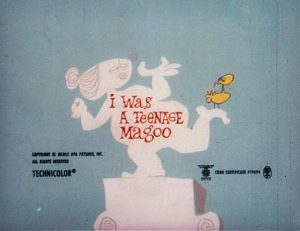


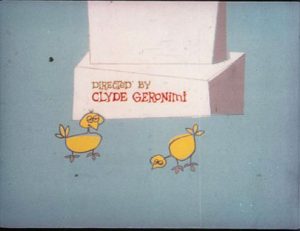

THE INTERVIEW (Pintoff Productions) Ernest Pintoff
Ernst Pintoff is an interesting character. A jazz trombonist and a cartoonist/animator who was influenced by UPA and joined that studio at its creative peak in 1955 – literally being allowed to make quirky independent films (for The Boing Boing Show) while on the payroll. He jumped from there to join Gene Deitch’s Terrytoon renaissance (Flebus), then started making independent shorts of note in his own studio (commercial work helping to pay the bills). More about Pintoff in our 1963 post (spoiler alert: he wins an Oscar). For now, here is early, typical Pintoff – a man-on-the-street radio (or TV?) interviewer doing a spot with a jazz performer. Like jazz itself, the dialogue feels improvised. The characters are funny – buts that’s all there is to it. It’s an expanded version of what he was doing at UPA – and there’s nothing wrong with that.
PICOLO (Zagreb) Dusan Vukotic
There was no doubt that by 1960 the Zagreb studio had arrived and – along with one of its founders, director Dusan Vukotic, who directed this film and The Cow On The Moon above – they would soon be recognized. But not just yet. These early films (which I adore) are clearly playing on the same field that UPA, Deitch and even Disney had trod. Vukotic and Zagreb would have to hold their breath till next year for a nomination. Picolo is another strong film, this one about two friendly neighbors who soon go to war (musically) when one of them buys a ‘small mouth organ’ (harmonica to you). Holy Moley, look at the design, at the color; It’s Toot Whistle Plunk and Boom on steroids! And perhaps that’s why it was snubbed – perhaps the Academy felt they had already seen it….
SNOOPY LOOPY (Columbia) William Hanna & Joseph Barbera
You’re not gonna make me watch another Loopy DeLoop cartoon, are you?
Loopy helps the stork make his delivery to the city zoo… its a baby ape, who soon gets loose and zee “hilarity” ensues. The little monkey goes here, goes there and Loopy gets clobbered at every turn. Not funny – and the timing seems particularly slow. I’m sure audiences at the Drive-In didn’t mind. The Academy ignored it too.
SOUTHERN FRIED HOSPITALITY (Lantz) Jack Hannah
You can boot the man out of Disney – but you can’t take the “Disney” out of the man. Jack Hannah joined the Lantz Studio after 25 years at the Duck Factory. This cartoon marked the first official appearance of Gabby Gator, who moves a lot and looks a bit like Donald Duck – if you squint. It’s sort-of like a Chip n’Dale cartoon with Woody Woodpecker in the chipmunks role. But those work because we have some sympathy for Donald… and Gabby is no Donald Duck. It’s paced like a Disney short — or perhaps I should say its paced like a Jack Hannah short… and for Lantz, that’s not a bad thing.
SPRINGY BRIDGEWORK (aka SAMSON SCRAP) (Paramount/Rembrandt) Gene Deitch
Munro (a one-shot) and Samson Scrap (intended as a TV pilot) we’re the first two projects Gene Deitch supervised at the helm of the ‘Bratri V Triku’ studio in Prague which he eventually took over. In fact, he directed both while commuting back and forth, to and from New York. Producer Snyder submitted both shorts to the Academy – one won the Oscar, the other was forgotten. I asked Gene to explain a little more about the Samson Scrap project:
“Samson Scrap was the name of the junkman character. Delilah was the name of his horse, Thus Samson Scrap & Delilah, the name of the intended series. Three episodes were made. The two young boy followers of Samson Scrap were named Pinetop & Washboard, named for black blues singer Pinetop Smith and Washboard Smith., ref. the use of a washboard as a cheap rhythm instrument. I named those kids as an inside joke for blues lovers. Those names did not relate to the stories…
“SPRINGY BRIDGEWORK was a cutesy title I gave to the first episode, in which the kids make a bridge between their two Brooklyn apartments by tying together a long bridge made of bedsprings rescued from Samsons Scraps heavenly junkyard. The series failed because of a social misreading by Allen Swift & me, basing the stories on our own childhoods, a time when we poor streetkids made our toys out of junk.
“Neither of us as kids had parents who could afford to buy us real bicycles or scooters. So we hammered stuff together from apple boxes, two-by-four wood scraps, and rusty rollerskates. We misread a time when already, toys were manufactured out of bright colored plastic, and.store-bought!
“But I think our SS&D shorts were good documents of the times when kids improvised their own toys out of scraps. The films were well made. “Old junk, Old junk! Whatve you got? may be junk to you, but to us its not!…”
TIN PAN ALLEY CAT (Terrytoons) Dave Tendlar
A one-shot Terrytoon – you don’t see them much anymore. This film is one of the last. The one-offs used to be labeled “Aesop’s Fables” – its fitting as the object of affection in this cartoon is a cat. The story is essentially told (in narration; to save time/money in lip sync?) by a human songwriter, Oscar Flick, who is inspired by the sounds of an alley cat into writing hit records – and is soon the toast of Broadway. A rags-to-riches-to-rags-again-then-back-to-riches story with great graphics by Tendlar. But not much else. Its a film about music, but even the music isn’t so good. It’s ultimately a generic modern studio cartoon. Eli Bauer wrote it… is that Tommy Morrison as Flick the narrator? I think it is.
TOP CAT (Paramount) Seymour Kneitel
It’s 1960 and at the Paramount Studio all your regular characters have been sold to a comic book company who is exploiting your library of “IP” on television. You still have 26 cartoons to deliver to Paramount Pictures; your budgets are cut and your staff is cut to the bone. What do you do, Bunky? You lift your head up high, take a walk in the sun… and you start making one-shots, hoping a new character will emerge. The front office is demanding new characters – Now! No time to create a character or even a name… how about “The Cat”?
I’m not convinced “The Cat” was ever supposed to be a series. There were only four, and they appear infrequently over the next two years – and there is little consistency among them. This first one at least has a nice little song. The Cat himself first appears literally half way through the cartoon. J.C. Bandwagon, the studio head, is the actual star of this cartoon as he takes us on his scouting trips to various locations in search of a star (could this be a parable on Seymour Kneitel’s experiences with Paramount brass who expected him to come up with another “star” like Popeye or Casper?).
J.C. meets ‘The Cat’ (Keith Scott informs me its impersonator Will Jordan doing a ‘Cary Grant’ voice – and other vocal impersonations) in Hollywood, singing about hats (according to the cue sheet, the song “The Right Kind of Hat” was written by Winston Sharples himself). Perhaps this story (by Irv Spector) was meant to be a sly take on show biz, or perhaps this was intended to become a TV series? I can’t explain Top Cat – but perhaps Joe Barbera was at the Academy screening and the title of this first cartoon inspired the name of the next prime time series he was pitching to ABC…
The earlier posts in this series: 1948, 1951, 1952, 1953, 1954, 1955, 1956, 1957, 1958 and 1959.
(Thanks to Libby Wertin, Don Yowp, Keith Scott, Devon Baxter and Mark Kausler for special contributions to this post)


 Jerry Beck is a writer, animation producer, college professor and author of more than 15 books on animation history. He is a former studio exec with Nickelodeon Movies and Disney, and has written for The Hollywood Reporter and Variety. He has curated cartoons for DVD and Blu-ray compilations and has lent his expertise to dozens of bonus documentaries and audio commentaries on such. Beck is currently on the faculty of CalArts in Valencia, UCLA in Westwood and Woodbury University in Burbank – teaching animation history. More about Jerry Beck [
Jerry Beck is a writer, animation producer, college professor and author of more than 15 books on animation history. He is a former studio exec with Nickelodeon Movies and Disney, and has written for The Hollywood Reporter and Variety. He has curated cartoons for DVD and Blu-ray compilations and has lent his expertise to dozens of bonus documentaries and audio commentaries on such. Beck is currently on the faculty of CalArts in Valencia, UCLA in Westwood and Woodbury University in Burbank – teaching animation history. More about Jerry Beck [



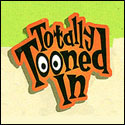
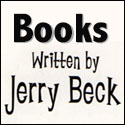


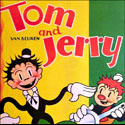
Regarding Goliath II,I would LOVE to see Disney make a feature-length version of it. They turned Tim Burton’s Frankenweenie from a 1984 short into a 2012 animated movie,they could do the same with Goliath II.
“9” was a 2005 Oscar nominated animated short that turned into a animated feature film (“presented by Tim Burton”) in 2009 (released 09/09/09) for Focus Films.
Possibly an idea for a Goliath II feature remake would be to do it as a live action/CGI animated film set in the jungles of India, instead of the setting of the original 1960 short. What do you think?
Too bad that both High Note and Mouse and Garden lost to Munro for the 1960 Oscar for best animated short.
Kind of a weird coincidence that Paramount had a cartoon called Top Cat – and then a year later the Hanna Barbera tv series Top Cat premiered on ABC.
Just imagine my reaction when I saw this cartoon at a 1963 kids matinee with “The Errand Boy.” I was aware of the H-B show and character and had seen him on cereal boxes, but since we didn’t have a TV from early ’61-early ’64, I had never seen TOP CAT the series. Now here, with Paramount titles, was a Top Cat who was colored the same yellow with white muzzle, but who, in no other way, resembled the one I knew from images. Not noticing the copyright, I was convinced that Paramount had copied H-B, and not the other way around. Knowing the production time it takes to do cartoons, of course, I’m dubious that there was anything shady involved.
Regarding Gabby Gator, on the other hand, it’s always been my theory that his existence–especially voiced by Daws Butler–was the reason the opening titles of the WALLY GATOR series show him in the swamp, while the series itself is set in a zoo. Somehow, someone at Lantz must have been made aware of the premise of the new H-B series and brought it up in a strong enough way to get them to change virtually everything about the basic premise. Whether that also affected the choice of voices Daws would use as Wally or not, I couldn’t say, but since Gabby sounds a lot like both Huck and Reddy, I kind of doubt they’d have gone to that voice again.
The two Zagreb shorts were great. I remember seeing The Cow on the Moon as a kid, and it’s still great fun. The styling on Piccolo is fantastic, as is the timing. Love the way Vukotic uses the graphic style for gags (the guy cutting the rain with scissors, for instance), something even UPA never tried.
Agreed! I’ve never seen anything from Zagreb, and those two shorts were just spectacular.
(Homer voice) “Mmmmmm… Susan Strasberg… drooooolllllll…”
The Zagreb toons really are a breath of fresh air in the midst of badly degraded Hollywood product. The musical intro and outro to Piccolo, just by themselves, are priceless.
My beloved Warner toons are obviously way past their “sell by” date at this point; even Jones had gone stale by then.
I’d never seen Top Cat before; thanx, Jerry. The name/title is one thing, but the cat’s character design bears more than a passing resemblance to Bill & Joe’s future TV star.
I’ll take Jo Morrow from last week, thank you kindly.
Can’t wait to see in the following weeks if the “Comic Kings” or any of the theatrically-released Terrytoon TV cartoons were submitted. I believe that even an episode from UPA’s The Dick Tracy Show was entered for consideration.
Mouse and Garden is neat with Daws Butler imitating Frank Fontaine for Sam the scraggly orange cat just like he did for Hanna-Barber as Mr Jinks and in Huckleberry Hound’s African Quarry Leroy the crazy lion!
Hey, why weren’t the full-length, theatrical versions of these late Mr. Magoo cartoons included on Shout! Factory’s set “The Theatrical Collection”? They would have been a natural bonus feature.
I’m sure it comes down to ownership since those three Magoo shorts are techincally owned by Classic Media/Dreamworks/NBC-Universal these days, Columbia/Sony only has the rights to the theatrical Magoo shorts they’ve owned from the beginning and that’s why the sets were separated that way. Whether original copies of those three shorts with their original titles/lengths exists or not is unkonwn to me (or Classic Media for that matter), though I’m sure it would’ve taken a lot more effort in locating them, like the print Mark Kausler has featured in these still frames!
Theatrical Technicolor prints of the other 2 self-distributed Magoo shorts definitely exist in private hands. On last week’s post, I linked to photos taken during a screening of “Boing Boing”. There are a small number of pricey Super 8 reductions of the “Frankenstein” entry that were offered for sale a few years back (supposedly from a 35mm IB Tech).
Whether the pre-print elements exist is anyone’s guess until Classic Media/Dreamworks Classics/whoever properly assess what film materials they still have in the vaults.
“I was a Teenage Magoo” had, sadly, already been done….. as “Kangaroo Courting” which was released in 1954. Tedd Pierce wrote that one too (while staying at UPA briefly away from Warners)….. I guess if he was going to be reunited with the character, why NOT redo one of his old stories? That one was more deserving of an Oscar than “Teenage Magoo”…. but, then, “When Magoo Flew” wouldn’t have won….. theoretically, anyway.
I may be in the minority, but I think that after the fairly lackluster 1958-1959 period, the Looney Tunes staff got a second wind for a couple years before burning out shortly before the cartoon studio’s close. It’s all the more impressive considering how much they were doing in that era, due to the double duty of “The Bugs Bunny Show”.
Anyway, 1960 had a lot of good Looney Tunes cartoons, including one of my all-time favorite Bugs shorts, “From Hare to Heir”, and a Road Runner cartoon, “Hopalong Casualty”, that had one of the series’ most memorable scenes, the earthquake pills gag.
Agree and I recall that “High Note” (which I really like) was in the “100 Greatest Looney Tunes” book (deservedly so).
… and it is not like the late fifties and early sixties product was all that bad compared to the competition. It is interesting how Maltin in MICE AND MAGIC really disliked such highly entertaining late releases like TRANSYLVANIA 6-5000 simply because they were different than something made a decade earlier. I do agree with the logic, however, that both the post-1958 BELL SCIENCE specials and the BUGS BUNNY SHOW of 1960-62 did distract some of the studio’s creativity away from the theatricals which were increasingly “economized” in their production. The TV show especially is incredibly creative and imaginative (which is why the Bugs “host” segments continued to be repeated on Saturday mornings well into the 1990s). In fact, this show very likely encouraged Disney to bring back animation to his TV show with the introduction of Ludwig Von Drake, after a few years focusing more on Zorro and Texas John Slaughter.
I’m not sure, but I believe the shorts released around the same time when the Bugs Bunny Show aired were made a few years before, owing to Warner’s backlog.
From Hare to Hare = the funniest ever death scene
I have to say, while I like the Woody short, I thought Hannah’s first three Gabby Gator shorts were a bit repetitive. I thought the last two were more interesting. That being said, I don’t mind any Lantz short NOT by Smith during the ’60’s so I kind of wish Lantz got nominated one last time. The animation may not been fluid as Warners or Disney, but it was way better than Paramount’s budget.
Also, I find it ironic they mention the then recent building boom of Florida at the time because a few years later, Jack’s former boss, the other Walt, was planning on something big in that area.
I’ve been wanting to see A Place In the Sun for some Time now, so many thanks for finding that one. From the date, it was posted at Youtube just prior to my last dedicated search for the short and I somehow missed it then.
The Zagreb shorts are great.
Add me to the list of people who never noticed such a nice copy of this was hiding in pain sight! A fairly eclectic list of submissions this year, hope the intriguing-sounding “Black Cat” two-reeler turns up sooner or later.
Re: SOUTHERN FRIED HOSPITALITY. I love the way Woody’s size changes as needed in these later cartoons. In some shots in this one, he’s just a little shorter than Gabby Gator, but when he’s doing his “show” on the stovetop, he appears to be quite small, much more so than he is in the rest of the cartoon.
Proving it wasn’t just Smith who did that with Woody in later cartoons. Heck, Dick Lundy did it even as early as “Drooler’s Delight” (1949) where, at the end, Woody is suddenly conveniently small enough to fit into a soda glass!
I recall Sid Marcus also doing it in “The Tenants’ Racket” (1963) not only with Woody, but with a birdhouse!
On Piccolo, I second what Jerry said about it being like Disney’s “Toot, Whistle, Plunk and Boom on steroids”. I’d add to that, as inspirations, the battle sequences between The Isle of Jazz and the Land of Symphony in Music Land (1935), and the musical chaos in Back Alley Oproar (1948) and Symphony Hour (1942) – all done at breakneck speed!
I agree with you, Jerry, that “The Cow on the Moon” should’ve gotten that nomination! Love the design and music in that one.
I cannot lie. I absolutely ADORE virtually all of the Zagreb stuff from their peak years of 1956-1973, although there were a few great ones made after that period too, despite both the National Film Board of Canada and Soyuzmultfilm stealing Zagreb’s thunder. Don’t know when Mladen Feman’s THE GREAT JEWEL ROBBERY (Krada Dragulja) and Vatroslav Mimica’s THE INSPECTOR CAME HOME (Inspektor Se Vratio Kuci) reached U.S. shores (both shown in Europe in 1959), but they would be my picks of the best-of-the-best.
Hi Jerry,
Here’s a much better copy of “Krava na Mjesecu”, restored with original Croatian titles: https://www.youtube.com/watch?v=6U7taVwQ1o8 (there’s a bonus cartoon about an ant if you’re interested)
It’s funny that they forgot to alter the “Kamenolom” (“Quarry”) signpost for the English language print. I guess the biggest mystery of the short is what is a cow doing in a quarry?
The design of the girl’s face might have well been influenced by the looks of another blonde, Melita Andres Vukotić, Dušan’s wife and frequent collaborator on scripts and production, who died just a week ago.
Thanks – that link is to a much better copy of THE COW ON THE MOON. Much appreciated!
OMG, this is the best looking copy I’ve ever seen, and the colors are nearly perfect for once (perhaps a little too much blue hues though maybe that was intentional)! I thought most of these suffered from being Eastmancolor prints.
I suppose unlike the opening title, perhaps it was a little out of the way and a hassle to go back and create a new background with an English sign just for that one scene to splice into an export dupe negative. In later years, Zagreb Film would do bilingual or multilingual credits to get around the need when it came to festival screenings of shorts like this, a practice they continue to do to this day.
There’s another copy of this same short on YouTube with what appears to be Polish credits as well, so perhaps they made several foreign language editions of the opening credits for each language without localizing the “Quarry” sign each time.
https://www.youtube.com/watch?v=6C_WHJnsNDE
Interesting if that’s true. I noticed the English credits mentioned Zlakto Grgic as “Head Designer” of this film, so now I wonder if Dusan gave him pointers to work his wife into the role of that girl like that. Of course Grgic would go on to become a unique animator/director in his own right, creating the famous Professor Balthazar series, collaborating with Bob Godfrey on “Dream Doll” as well as teach animation for Sheridan College up in Canada before his death.
The design of that girl especially make me think of Dexter from Dexter’s Laboratory. I wonder if Genndy Tartakovsky was inspired by this short to do that? Even the boy is somewhat Dee Dee-like!
Then Jerry went…
I was hoping Zagreb Film would put that up on their website themselves (or YouTube) but I guess not. They did spruce up their website though, looks pretty snappy though it could use some photos/videos!
http://zagrebfilm.hr/en/
Damn, that’s one gorgeous copy indeed. Is it sourced from a DVD or something?
MAN! That print is indeed great. Much better than the one Steve Stanchfeld had on his “Mid Century Modern Vol. 1”.
Re: Iggy:
This is true; however, I personally feel that WB’s “second wind” carried into 1961 and early 1962, which is likely when the backlog would’ve ended. The first truly bad Looney Tunes cartoon in a few years, “The Slick Chick”, didn’t debut until July 1962.
Stock music breakdown for “I Was a Teenage Magoo”/”Teenage Magoo”:
0:00- Magoo Cartoon Theme- Carl Brandt
0:06: ?
0:17: Laughing Jackass- Ronald Hanmer
1:01: ?
1:21: Bozo’s Polka- Fredric Bayco
1:57: ?
2:03: Leap for Joy- Cedric King Palmer
2:35: ? (Darrell Calker?)
2:51: Spring Song- Felix Mendelssohn (unknown arranger)
2:55: ?
3:11: ?
3:21: ?
3:30: ?
3:41: More Comical Cuts- Ronald Hanmer (cut #8)
3:44: ?
4:06: Laughing Jackass- Ronald Hanmer
It’s all stunning. Now, in the year 2017 I’m seeing this for the first time, Bill Snyder, grinningly crazily, while clutching my Oscar, which he ordered to have engraved with his name only, while saying to the world, which at the time knew none of us, “Thanks to Gene, Jules, and Al.” I love his son Adam, who has done so much to make it right for me. As for Bill, may he rest in peace.
Pictures of original titles and scenes from “Magoo Meets Frankenstein” (1960)
http://2.bp.blogspot.com/-2lRM8DtCj-A/TgKtKqRXEnI/AAAAAAAAA88/KKxekVDZ-jk/s400/Drive-In%2B30.JPG (UPA Presents…)
http://3.bp.blogspot.com/-R4n3-UheFmc/TgKuALGua-I/AAAAAAAAA9E/QzLFDgTcKaE/s400/Drive-In%2B31.JPG (Mr. Magoo)
http://1.bp.blogspot.com/-g2BKK8Ab138/TgKuAgYiaZI/AAAAAAAAA9M/N6Joq2aooUA/s400/Drive-In%2B32.JPG (Main Title)
http://3.bp.blogspot.com/-qdb4aKYJyDE/TgKuA3ab1uI/AAAAAAAAA9U/bbNWrG4ebW4/s400/Drive-In%2B33.JPG
http://4.bp.blogspot.com/-GPb6s7anlUY/TgKuBDC7GHI/AAAAAAAAA9c/F7z9b_krR4g/s400/Drive-In%2B34.JPG
The longer version of the song “The Right Kind of Hat” used in the Paramount short “Top Cat” (1960) can be found here:
https://www.youtube.com/watch?v=OZR4H_NizN8&t=8m53s